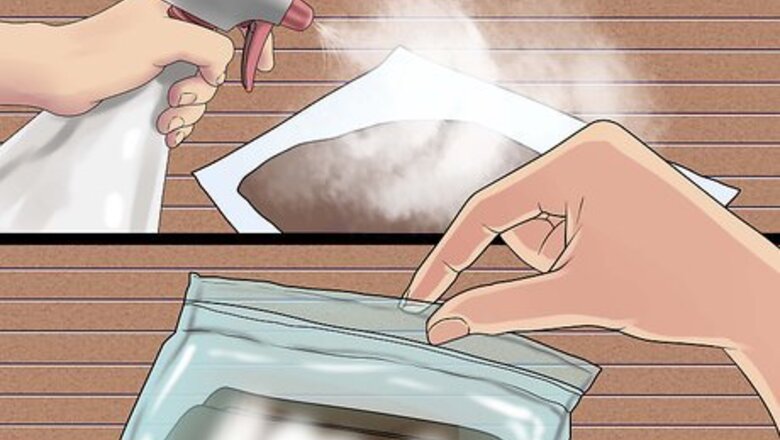
views
Preparing the Tobacco Leaves
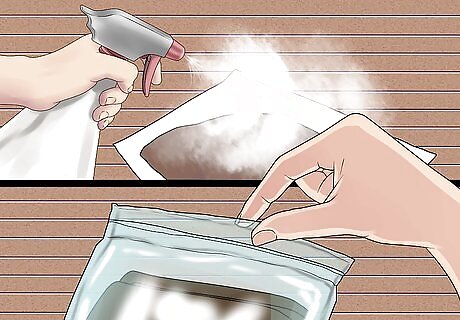
Moisten your tobacco leaves. Before they can be rolled, your leaves must be moistened or "cased." You can use a fine mist of water or a humidifier to moisten the leaves. Placing the leaves in a large plastic bag with a bit of water will also do the trick. The amount of water you need, and the length of time your leaves should be moistened, depends on the type of leaf you are working with. Very dry leaves will need to be exposed to more moisture than less dry leaves. Experiment with different volumes of water and periods of absorption to find out how you can get the most pliable leaf.
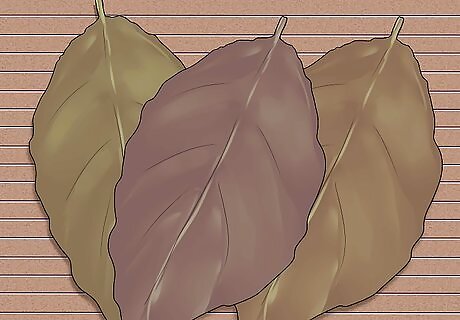
Select your wrappers. Wrappers are thinner, larger, and more malleable than the other leaves used in the cigar. They will be used to hold the other leaves together and form the outer "skin" of the cigar.
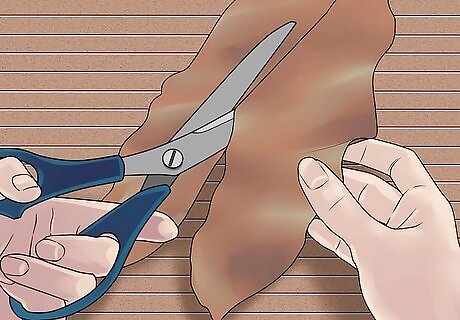
Cut the central vein out of the wrapper leaves. This vein is identified by tracing the stem up through the leaf to its tip. By cutting the leaf vertically along each side of this central vein, you will ensure the wrapper will be as smooth as possible. If you wish, you can make your wrapper even smoother by pressing it briefly with a warm iron or a rolling pin. The most intact and aesthetically pleasing leaves should be used as wrappers.
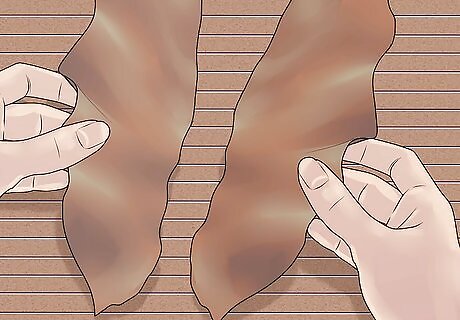
Select your binder. The binder will hold the filler leaves before being covered by the wrapper. Midgrade leaves -- those which are intact enough to contain filler leaves but not acceptable as wrappers -- make good binders. Like the wrapper, the binder will need to be deveined. Cut the leaf along either side of the stem so that you end up with two roughly symmetrical halves.
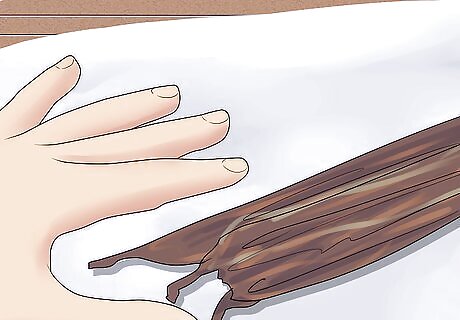
Select your filler. Fillers are placed in the innermost core of the cigar, and are surrounded by the binder leaf. You can shred your filler into smaller, finer pieces if you wish. Choose the most aesthetically problematic leaves for filler. Leaves with holes or uneven coloring are the best options for filler leaves. Keep your filler leaves a bit drier than the binder or wrapper leaves, but ensure they remain flexible. Since filler comprises the bulk of the cigar, flavor is an important factor when choosing filler leaves as well. Sample different varieties of tobacco to find one you like.
Assembling Your Cigar
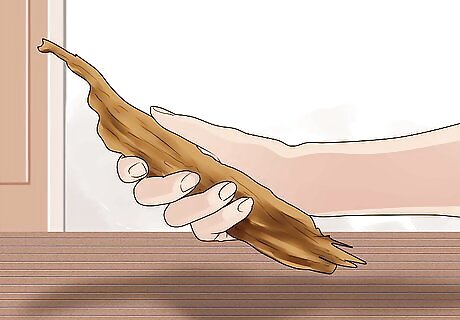
Form your filler leaves into a bunch. Grab a handful of rolled leaves with the ends sticking out of your clenched hand. The length of your bunch -- and the length of the whole cigar -- is a matter of personal preference. Most range from 5 to 7 inches long. Put the thickest leaves in the center of the bunch, and wrap each leaf in progressively thinner leaves. This layering effect prevents tunneling (inability of the wrapper leaf to burn) when it is eventually smoked. How many filler leaves should you use? This is, again, largely a matter of preference. However, keep in mind that too many leaves will prohibit proper air flow; too few leaves will make the cigar burn too quickly and too hot.
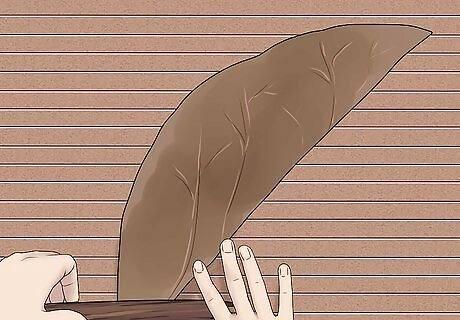
Lay the filler bunch on a binder leaf. The binder should be face down, with the veins of the leaf visible. Angle the binder at about 45° to either side, but make sure to lay one end of the filler bunch on the starting end of the binder leaf, with the rest of the filler directed out towards the side where the upper edge of the binder leaf leads. For instance, if the binder is on the table and angled diagonally toward the upper right, place the filler bunch on the binder in an elongated horizontal (left-to-right) position with the left end of the bunch against the leftmost end of the binder. Don’t squeeze the bunch too tightly when placing it on the binder leaf. If you’re using shredded filler, lay the binder leaf flat on the table, veined side up, and line your binder up as if it composed a single bunch.

Roll the binder leaf. To roll the cigar, fold the pointed end of the binder leaf slowly over the filler leaves. Tuck the folded-over edge beneath the filler, just as you might when making a sushi roll. Give the binder a small pull towards you to compress the filler leaves a bit, but don’t pack the filler too hard into the binder. With your fingertips on the semi-rolled binder leaf, continue to roll it by moving your fingertips up and over the cylinder, directly away from your body. Move from one end to the other, starting at the pointed end and rolling towards the wider, rounder end. Roll the cigar across the table a few more times to work it into a more perfect cylinder. Use the same technique you did the first time, taking your fingertips up and over the cylinder and stopping when you’ve rolled it into your palm. You may need to cut excess leaf if the cylinder you made is longer than you’d like. You can use a sharp kitchen knife, or a ‘’chaveta’’, the traditional cigar-cutting tool used by professional rollers.
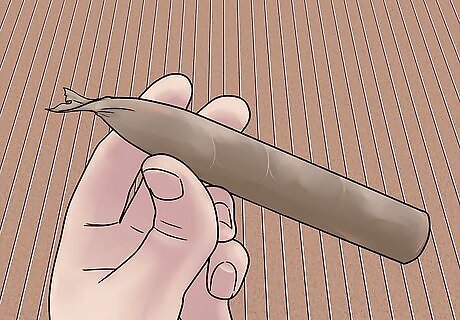
Select your head and foot. One end of the cigar must be the head (the end of the cigar you inhale from) and the other the foot (the end of the cigar you light). Twist the head to a rough point by turning the cigar lightly in one hand while gently pinching the head between your thumb, middle, and pointer finger. Give it a few rotations, just enough to ensure it holds its shape. You will refine it later, so don’t bother trying to make it look like a perfect cigar you’d pull from a box.
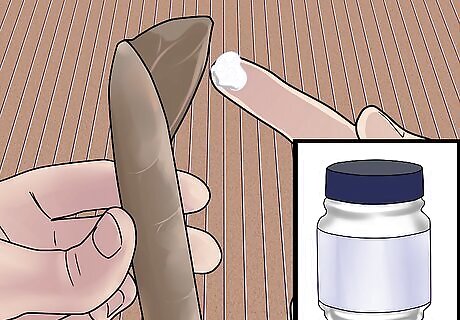
Seal the binder leaf. Apply a small amount of egg white, cigar glue, Tragacanth, or guar gum to the bottom edge of the inside of the leaf (the side facing up) to keep it from unrolling. If you have access to a cigar press or mold, place the cigar in it when ready. Cigar presses help make the cigar more symmetrical and give them a finished look. Cigars at this stage are pressed for 30-45 minutes. After the designated time period has elapsed, the cigars are removed and rotated 90° before being reinserted into the press for another pressing equal in time to the first. It is important to turn the cigar to ensure that you don’t end up with a seam jutting out of one side or the other.
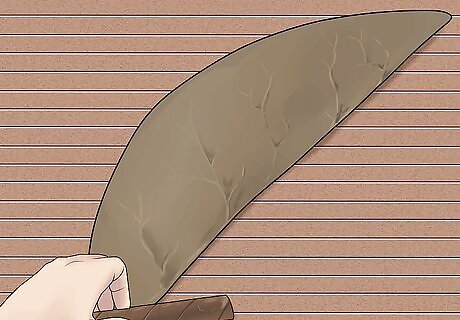
Place the wrapper face down on the table. The face of the wrapper leaf is the smoother of the two sides. The other, veined side should face inward when the cigar is rolled.
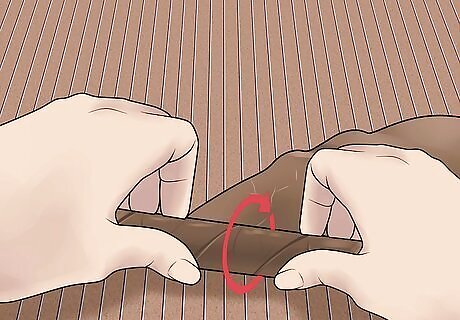
Roll the wrapper. The rolling process is not much different than the rolling of the binder leaf, but should be done with greater care. With the wrapper leaf angled diagonally relative to you, fold the pointed end of the wrapper leaf slowly over the cylinder (composed of filler cased in binder). Tuck the folded edge beneath the binder and begin to roll. Place your fingertips on the semi-rolled cigar, and continue to roll it by moving it out and away from you slowly. Move from one end to the other, starting at the pointed end and rolling towards the wider, rounder end. Apply a light layer of cigar glue over the inside of the wrapper leaf as you roll it. Use your non-rolling hand to pull the wrapper taut as you apply it to the binder to ensure the finished product has a smooth outer surface. A good roller will roll the leaf tip towards the foot or tuck end (where the cigar is lit). Doing so will ensure the cigar gains a more robust flavor as it is smoked.
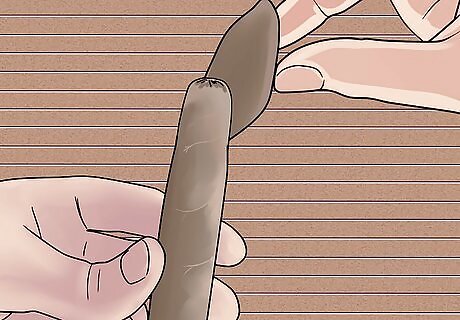
Apply a cap. The cap is formed from leftover scraps of the wrapper leaf and affixed to the head of the cigar (where you inhale). Like the binder, the cap should be sealed with Tragacanth, cigar glue, or guar gum. Cut a “D” shaped piece out of the wrapper leaf. The long edge of the D should be about one quarter the length of the cigar. Apply some cigar glue to the veined side of the cap. Grip the cigar in a vertical position with one hand and apply one corner of the cap at an oblique angle from the cigar. At this point, if you laid the cigar down in line with your body, with one end of it close to you and the other end further away from you, one corner of the D-shaped cap would be affixed to the cigar near the far end, and the other corner of the D-shaped cap would lie beyond the end of the cigar and slightly to one side or the other. Roll the cap around the cigar. The curvature of the D should allow you to end up with an open hole at the end of the cigar whose edge is relatively flat. Use some cigar glue to close the end of the cap. Gently pinch it closed and twist it slightly in your hand to ensure the cap comes to fine point.
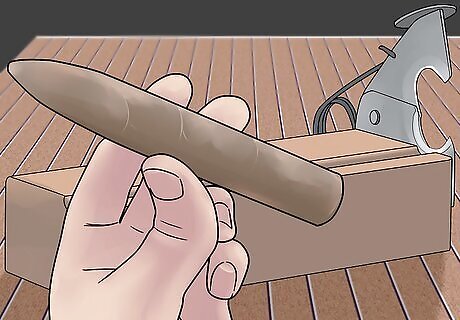
Apply the finishing touches. The only really crucial step left at this point is to dry the cigar on a drying rack for 24-48 hours. The wrapper will then tighten around the cigar as it dries. But there are several things you can do to make your cigar look and feel like a more complete product. Place the cigar in a tuck cutter to trim excess leaf. A tuck cutter is a device designed to precisely cut the end of the cigar that you light (the tuck end or foot). This will give the cigar its proper length. Alternately, you can simply take a sharp knife to the end and gently cut through it. Drop the cigar in the cigar press for a final pressing. You could press the cigar for up to 12 hours depending on how attractive you want to make the finished product. Turn the cigar 90° after the designated time period has elapsed and press it again on that side for an equal amount of time. If you don’t want to bother with a cap, simply pinch the head again when you’ve completed rolling it, sealing it with a bit of cigar glue, guar gum, or similar agent. Turn the cigar on its long axis as you pinch it between your thumb, pointer, and middle finger to ensure it doesn’t unroll.




















Comments
0 comment